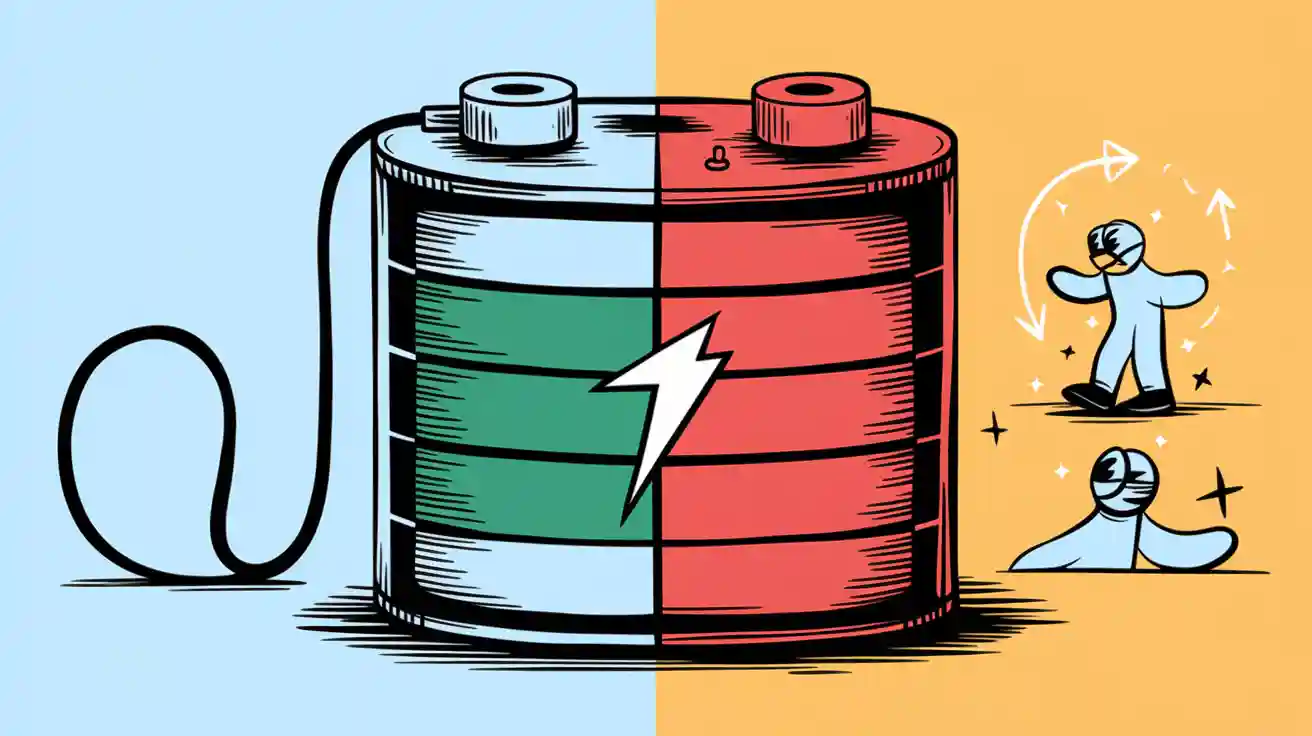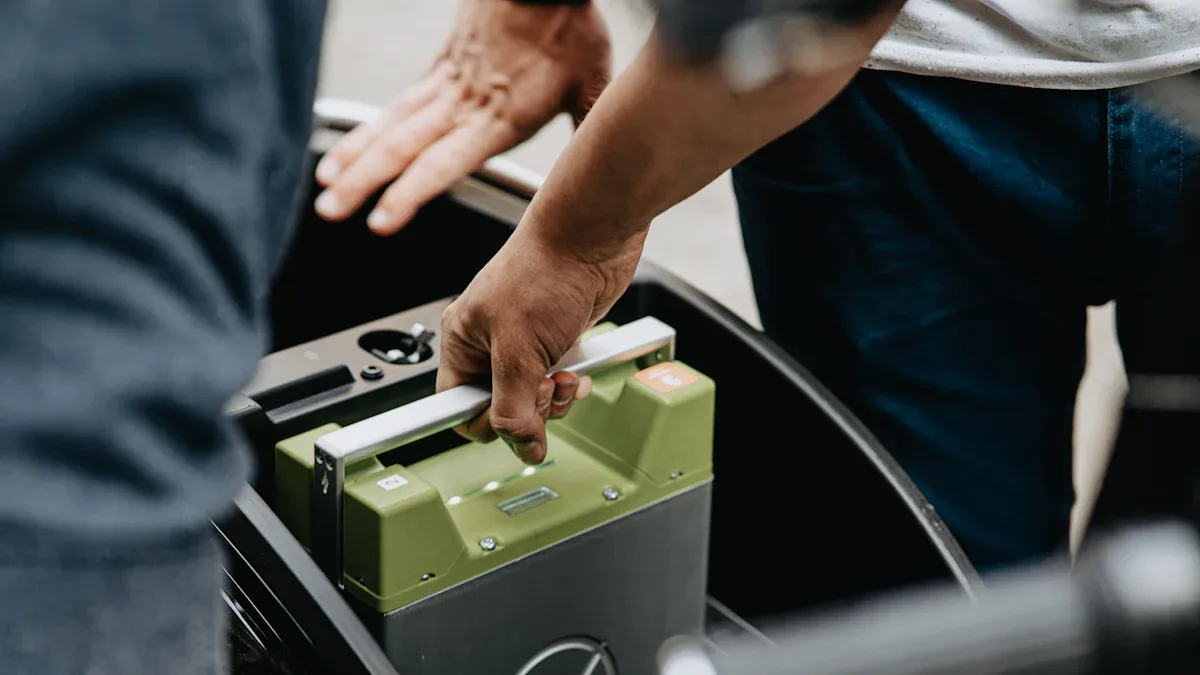
Choosing between shallow charging and deep discharge for LiFePO4 batteries directly impacts their lifespan. Shallow charging slows aging, with decay ratios showing up to 1.92 times less wear compared to deep discharge at higher temperatures. However, improper practices, such as overcharging, can trigger thermal runaway, gas formation, and swelling, reducing the battery’s lifespan. Proper charging methods are essential to maximize the LiFePO4 battery lifespan and avoid potential hazards of long-term shallow charging/discharging for LiFePO4 batteries.
Key Takeaways
Charging a LiFePO4 battery less fully helps it last longer. Try charging it to about 75% to get more uses.
Using more of the battery’s power can wear it out faster. Keep the battery between 20% and 80% for it to last longer.
Use a Battery Management System (BMS) to check voltage. It stops overcharging or draining too much, keeping the battery safe and working well.
Part 1: Understanding Shallow Charging and Deep Discharge

1.1 What is Shallow Charging in LiFePO4 Batteries?
Shallow charging refers to the practice of charging LiFePO4 batteries without fully utilizing their capacity. This process involves two distinct phases: constant current charging, which constitutes the bulk of the charging cycle, and constant voltage charging, which acts as a trickle charge to top off the battery. During charging, lithium ions migrate from the positive electrode to the negative electrode. Maintaining proper voltage levels is critical; exceeding 3.65V per cell can damage the positive electrode structure, while discharging below 2.0V risks irreversible harm. Shallow charging helps extend the LiFePO4 battery lifespan by reducing stress on the battery’s internal components. However, overcharging or improper voltage management can lead to swelling, gas formation, or thermal runaway, compromising safety and performance.
1.2 What is Deep Discharge in LiFePO4 Batteries?
Deep discharge involves using a significant portion of the battery’s capacity before recharging. LiFePO4 batteries are designed to handle deep discharge cycles effectively, offering a cycle life of 2,000 to 5,000 cycles depending on the depth of discharge and usage conditions. These batteries can sustain high discharge rates without losing efficiency, making them ideal for applications requiring rapid energy delivery. However, deep discharge generates heat, necessitating robust thermal management systems to prevent overheating.
Parameter | Description |
|---|---|
Cycle Life | LiFePO4 batteries can endure 2,000 to 5,000 cycles, influenced by depth of discharge and usage. |
Discharge Rates | Capable of managing high discharge rates without significant efficiency loss, crucial for fast energy delivery. |
Thermal Stability | High discharge rates can lead to heat generation, necessitating effective thermal management solutions. |
1.3 How LiFePO4 Battery Chemistry Differs from Other Lithium-Ion Batteries
LiFePO4 batteries stand out due to their unique chemistry and structural advantages. Unlike other lithium-ion batteries that use cobalt, nickel, or manganese-based cathodes, LiFePO4 batteries rely on lithium iron phosphate. This composition offers superior thermal stability and safety, eliminating the risk of thermal runaway. While their nominal voltage is slightly lower (~3.2V per cell compared to ~3.6–3.7V per cell in other lithium-ion batteries), they compensate with a longer cycle life, often exceeding 2,000 cycles.
Robustness: LiFePO4 handles deeper discharges (e.g., 80–90% DoD) better than NMC/LCO batteries, making it suitable for applications requiring regular high DoD (e.g., solar storage).
Voltage Stability: Flat discharge curve (3.2–3.3V for most of the cycle) means voltage remains stable until near-empty, reducing sudden drops.
LiFePO4 batteries may have lower energy density, but their unmatched safety and longevity make them a preferred choice for applications requiring reliability and durability.
Part 2: Impacts on LiFePO4 Battery Lifespan
2.1 Effects of Shallow Charging on LiFePO4 Battery Health
Shallow charging can positively influence the health of LiFePO4 batteries when done correctly. By limiting the state of charge (SoC) to around 80%, you can reduce stress on the battery’s internal components, which helps extend its cycle life. Studies show that shallow cycles at low charge rates result in minimal measurable degradation. For instance:
A user reported no noticeable capacity issues after 2.5 years of shallow charging, even in cold conditions.
Another user suggested that charging only to 80% SoC yields more cycles, highlighting a strategy for maintaining battery health.
Calendar aging, however, remains a critical factor in determining the expected lifespan of LiFePO4 batteries. At 50% SoC and 25°C, these batteries can last approximately 23.8 years before degradation reaches 80%. This longevity underscores the importance of proper charging habits and avoiding overcharging to maximize battery health. While shallow charging minimizes frequent charge cycles, it’s essential to balance this practice with optimal performance needs to ensure the battery delivers reliable energy over several thousand cycles.
2.2 Effects of Deep Discharge on LiFePO4 Battery Health
Deep discharge cycles allow you to utilize a significant portion of the battery’s capacity, but they come with trade-offs. High depth of discharge (DOD) accelerates aging by stressing the cathode structure and electrolyte. Research confirms that deeper discharge cycles increase mechanical stress in active materials, leading to faster capacity fade. For example:
Rumpf et al. (2015) found that increased DOD leads to faster capacity fade due to structural stress.
Yang et al. (2019) concluded that deeper discharge cycles accelerate capacity loss by increasing mechanical stress.
Despite these challenges, LiFePO4 batteries are designed to handle deep discharge cycles effectively. Their robust chemistry ensures they can endure several thousand cycles without significant efficiency loss. However, to maintain optimal charge/discharge performance, you should avoid over-discharge, as it can lead to irreversible damage. Limiting DOD and managing the frequency of charge/discharge cycles are critical factors for preserving battery health and extending its lifespan.
2.3 Potential Hazards of Long-Term Shallow Charging/Discharging for LiFePO4 Batteries
While shallow charging and discharging can enhance cycle life, prolonged use of these practices may introduce potential hazards. Long-term impacts include accelerated aging due to structural stress and side reactions at low SoC. Studies highlight the risks associated with improper charging and discharging cycles:
Peterson et al. (2010) confirmed that high DOD accelerates degradation due to structural stress.
Schmalstieg et al. (2018) analyzed long-term cycling data, revealing that deep discharges increase capacity fade due to internal resistance.
Keil & Jossen (2017) quantified the correlation between deeper DOD and capacity fade, emphasizing the importance of limiting DOD for longevity.
To minimize these risks, you should adopt proper charging habits and avoid overcharging or over-discharging. Leveraging advanced battery management systems (BMS) can help regulate charging and discharging cycles, ensuring optimal performance and extending the LiFePO4 battery lifespan. By balancing shallow charging and deep discharge practices, you can achieve reliable energy delivery while safeguarding the battery’s health over its expected lifespan.
Part 3: Addressing Common Misconceptions About LiFePO4 Batteries
3.1 Myth: Shallow Charging Always Extends LiFePO4 Battery Life
Many believe that shallow cycling or maintaining a shallow depth of discharge always extends the life of LiFePO4 batteries. While shallow charging can reduce stress on internal components, it is not a universal solution. Over time, shallow cycling at low states of charge (SoC) can lead to side reactions within the battery, causing capacity fade. Additionally, shallow charging may not fully utilize the battery’s capacity, which could limit its efficiency in applications requiring high energy output.
To maximize the lifespan of your LiFePO4 battery, you should balance shallow charging with periodic full cycles. This approach ensures the battery remains calibrated and avoids potential issues like uneven cell balancing. Proper charging practices, combined with a reliable battery management system (BMS), can help you achieve optimal performance and longevity.
3.2 Myth: Deep Discharge is Always Harmful to LiFePO4 Batteries
Contrary to popular belief, deep discharge is not inherently harmful to lithium iron phosphate batteries. These batteries are designed with enhanced chemical stability, allowing them to endure repeated deep discharges without significant degradation. This feature sets them apart from traditional lithium-ion batteries, which are more prone to thermal runaway and capacity loss under similar conditions.
However, frequent deep discharges can accelerate aging if not managed properly. You should avoid over-discharging, as it can cause irreversible damage to the battery. Maintaining a recommended depth of discharge, such as 80%, ensures you can utilize the battery’s capacity effectively while preserving its life.
3.3 Myth: LiFePO4 Batteries Don’t Require a BMS for Longevity
Some assume that LiFePO4 batteries can operate efficiently without a BMS. This is a misconception. A BMS plays a critical role in optimizing the lifepo4 battery lifespan by monitoring and managing key parameters.
It continuously checks individual cell voltages to prevent overcharging or deep discharging, which can damage the battery.
It estimates the State of Health (SOH) to provide insights into the battery’s condition and remaining life.
It ensures cell balancing, equalizing charge levels among cells to prevent imbalances that could reduce lifespan.
It monitors voltage, temperature, and current to prevent overheating and maintain performance.
By integrating a BMS, you can safeguard your battery against potential risks and ensure reliable operation over its extended life.
Shallow charging reduces stress on internal components, while deep discharge utilizes more capacity but accelerates aging. To maximize the lifespan of your LiFePO4 battery, maintain a depth of discharge between 20% and 80%. Use a reliable BMS to monitor cycles, voltage, and resistance. Periodic checks ensure optimal performance and prevent long-term issues.
FAQ
1. How often should you perform a full charge cycle for LiFePO4 batteries?
Perform a full charge cycle every 30-50 cycles to recalibrate the battery and maintain accurate state-of-charge readings.
2. Can LiFePO4 batteries be stored for long periods without charging?
Yes, store them at 50% state of charge in a cool, dry place. Avoid extreme temperatures to prevent capacity loss.
3. What is the ideal charging temperature for LiFePO4 batteries?
Charge LiFePO4 batteries between 0°C and 45°C. Charging outside this range may reduce efficiency and lifespan.
Tip: For professional guidance on charging temperature, visit Large Power.






